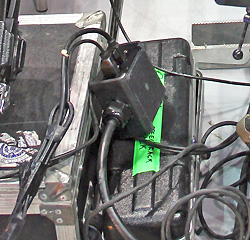
Guitars are just about your most sensitive signal output devices on stage, and the only place a high-quality snake isn’t your best option for clean wire dress. Guitar cords in general can account for a lot of your mid-show pain.
Per the signal level and impedance issues mentioned above, they are prime sources of induced (beer signs, lighting dimmers, radio signals, etc.) and self-generated (microphonics, crackles and pops) noise.
Plus, in a live performance they get worked more than the other cables and have to survive that on a nightly basis without getting progressively worse in the noise department before failing.
Guitar Cords That Sound Best & Survive:
1) Braided Copper Shield/Foil shields are significantly stiffer, making them annoying to performers connected to them and they deteriorate with constant flexing, making them fine for the studio or in a snake, but a time bomb for the guitarist on stage. Shields which are simply spiral wrapped will “spread” when you flex the cable, providing openings for those nasty outside sounds to jump into the guitar signal. The braid is a key issue.
2) Conductive Inner Wrap. A conductive inner wrap under the shield will increase shielding and also reduce microphonics. This can be harder to spot, but becomes obvious when you smack the cable around. Some cables make a lot of noise when they get tapped. Good ones don’t.
3) Low Capacitance. This will matter with some guitar/pickup/amp combinations, and not with others. If your guitars all have onboard electronics, it shouldn’t be an issue. For some of the classics, it’s a big deal. So you don’t have to think about it, lower capacitance is better. Try to stay under 50pf a foot if you can get the specs on the cable.
4) Strain Relief. A flexible molded boot protecting the last few inches of the cord before it enters the plug. This is a life-expectancy issue. Most cord fatigue takes place at the point where the nice flexible cable enters the hard inflexible plug.
5) Multiple Copper Stranding. Look for multiple fine copper strands for the inner conductor. These provide flexibility while keeping resistance low.
Esoteric audio people may tell you the extra surface area created by fine stranding also helps high frequencies due to “skin effect.” They’ll probably add that you should use oxygen free” copper for a better sound (actually, “oxygen free” really means “less oxygen,” with different OF cables giving you different amounts of Oxygen Freeness).
These intriguing possibilities aside, more fine strands for a given inner conductor gauge translates to more suppleness and greater life expectancy on stage.
Get It Together
Done right, a set change is as easy as giving the sound company a set of numbered XLR tails (even if you are the sound company).
At the house console, pre-wiring of the effects rack(s) and a short insert snake or wire bundle are the path to a fast, predictable setup. If it will be the same board every night, you may have the luxury of using a multipin disconnect between your rack and the board.
If you’re going to be hanging this rack off a different board every night, the most practical solution can be to have your insert snake’s console fan-out be TRS stereo phone plugs and carry a bag full of TRS to dual-mono phone adapters for the boards that have separate in and out jacks.
Finally, every sound tech needs a bag of black box goodies to get you through emergency situations that are not usually of your making. A good cable tester, miscellaneous adapters, in-line phase reversers, ground lifters and pads are indispensable. A few emergency 9-volt batteries never hurt either.
Carl Cornell has been the chief engineer at Whirlwind for over 20 years. He has also mixed performance audio professionally since discovering (much to his dismay) in 1968 that he had no future in front of the mic.
